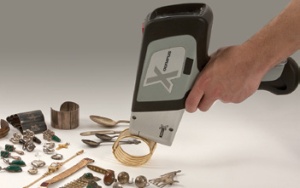NARNIA: the Magical Land of Archaeological Science
NARNIA, or the mouthful New Archaeological Research Network for Integrating Approaches to ancient material studies, is a research project funded by the EU through the Marie Curie Initial Training Networks. The project’s lengthy title, abbreviated into a snappy acronym reminiscent of fantastic tales and adventures defines its purpose well: to build an interdisciplinary network between participating organizations and to facilitate work of young researches in cutting-edge disciplines of archaeological science. Network, coordinate, collaborate, integrate – a modern approach to doing archaeology.

Peter Grave using PXRF to reveal the elemental signature of a basalt axe head.
Photographer: Cate Lowe
Rights: © Australian Museum
However, NARNIA also has outreach training courses and workshops intended for interested parties not directly involved in the project. These range from technical training courses on specific methodologies (eg. applications of PXRF) to broader theories and practices of documentation and conservation of ancient materials.
Why would you care if you are not the one pointing lasers and peeking through microscopes? For one, trying to extract as much interpretable data from materials and objects as possible using multiple macro- and microscopic methods is a longstanding trend in archaeology. Everything matters; such multidisciplinary approaches drive a lot of modern research and excavation, especially lately as competition is increasing and funding is scarce. Archaeologists study the past but are nowadays very oriented towards the future – enthusiastic about potential new horizons afforded to them by new technologies – and even if they aren’t, they still might end up collaborating with a colleague who very much is. For this reason training workshops such as NARNIA’s are not only useful to young researchers working towards a particular specialization, they are of potential value to other (fieldwork) archaeologists, conservators and heritage workers who wish to update their knowledge on the latest developments in archaeological science as well as to connect with specialists with whom they (didn’t even know they) might want to collaborate. For them, it is important to maintain scientific rigor through having a thorough understanding of how to choose methods that are suitable for the questions being asked, what they can and cannot do along with how to interpret results appropriately.
The workshops are also valuable to students for networking purposes as well as to get a better grasp of what archaeological science actually entails, especially if they are interested in pursuing further studies and a prospective career in these disciplines. Students study archaeology mostly through readings, lectures and practical work in controlled conditions, where they disproportionately deal more with the end-results of others’ (sometimes lifetime) accomplishments and spend less time talking about the drudge-work of field and lab archaeology, i.e. the day-to-day life of an archaeologist. By participating in excavations or lab work, students experience the process of archaeology, rather than just having a glamorized and sometimes (or most times?) misleading mental image of being an archaeologist and can therefore better conclude if such a lifestyle appeals to them and which aspects of archaeology they truly wish to pursue. However, if latest developments in methodologies interest them and their school or organization doesn’t have resident experts and facilities, eg. a radiocarbon dating lab, workshops like NARNIA’s can be a great opportunity to experience and to be inspired by the vibrant future of high-tech archaeology. Interested? Off to NARNIA then!
Sandra Šoštarić graduated in Prehistoric Archaeology, with a focus in bioarchaeology of human bones. Her main interests involve health and disease of past human populations as well as the use of new technology and digital solutions in archaeological research. Having had a breadth of practical experience in different facets of archaeology and related disciplines, from digital documenting of excavations to forensic anthropology, she realizes she loves the past almost as much as the future.


